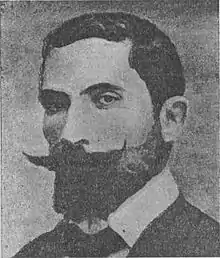Shimon Moyal
Shimon Moyal (1866–1915) was a Zionist activist and physician. He worked for several newspapers and started a short-lived newspaper with his wife, Esther Moyal. He was the translator of the Talmud into Arabic language.
Shimon Moyal | |
|---|---|
 | |
| Born | 1866 |
| Died | 1915 (aged 48–49) Jaffa |
| Occupation | Physician Translator |
Notable work | At-Talmud: Asluhu wa-tasalsuluhu wa-adabuhu |
| Spouse(s) | |
| Parent(s) | Yousef Moyal (father) |
Early life and education
Moyal was born in Jaffa in 1866.[1] His father was Yousef Moyal whose family were wealthy Jewishs from Morocco who settled in Palestine.[1][2] Shimon's brother, David Moyal (1880–1953), was a lawyer and activist.[2] Shimon attended Jewish religious schools in Palestine.[1] Then he went to Beirut where he studied Arabic and French languages.[1] Next he studied medicine in Cairo.[3]
Activities and career
During his studies in Cairo and later Moyal worked for different publications.[3] One of them was Al Muqattam, a Cairo-based newspaper.[4] He and his wife, Esther Moyal, returned to Palestine in late 1908.[3][5]
In 1909 Moyal published an Arabic translation of Talmud entitled At-Talmud: Asluhu wa-tasalsuluhu wa-adabuhu (The Talmud: Its Origin, Transmission, and Ethics) to make Judaism much more known by both Muslims and Christians who could read the Arabic texts.[1] In 1913 he and his friend Nissim Malul launched a Jewish newspaper, Sawt Al Uthmaniyah (the Voice of Ottoman), which was published in Arabic.[3] The paper was edited by Moyal and his wife.[3] Moyals and Malul also founded an association, Ha-Magen (The Shield), which aimed to answer to any hostile article against Zionism published in the Arabic publications.[3] Another goal of the association was to encourage greater understanding between Jews and Arabs in Palestine and to support the peaceful relations with Arabs living in the region.[3] Moyal was also very active in the Jaffa freemasonry society and participated in the activities of the Decentralization Party in Egypt (Al-Lamarkaziyah).[3]
Personal life and death
Moyal married a Beirut-born Jewish journalist Esther Al Azhari in 1894.[3][6] They had a son, Abdullah Ovadia Nadim.[7] He died in Jaffa in 1915 at the age of 49.[1]
References
- Jonathan Marc Gribetz (Fall 2010). "An Arabic-Zionist Talmud: Shimon Moyal's At-Talmud". Jewish Social Studies. 17 (1): 1–4. doi:10.2979/JEWISOCISTUD.17.1.1.
- Yuval Ben-Bassat (2020). "Reconsidering the role of a Maghrebi family in the Yishuv in late Ottoman Palestine: the case of the Moyal family". Journal of Modern Jewish Studies. 19 (4): 501. doi:10.1080/14725886.2020.1763071.
- Abigail Jacobson (2004). "Alternative Voices in Late Ottoman Palestine: A Historical Note". Jerusalem Quarterly (21).
- Salim Tamari (2014). "Issa al Issa's Unorthodox Orthodoxy: Banned in Jerusalem, Permitted in Jaffa". Jerusalem Quarterly. 59: 30.
- Moshe Behar (2017). "1911: the birth of the Mizrahi–Ashkenazi controversy". Journal of Modern Jewish Studies. 16 (2): 314. doi:10.1080/14725886.2017.1295588.
- Reuven Snir (2007). ""Mosaic Arabs" between Total and Conditioned Arabization: The Participation of Jews in Arabic Press and Journalism in Muslim Societies during the Nineteenth and Twentieth Centuries". Journal of Muslim Minority Affairs. 27 (2): 266. doi:10.1080/13602000701536208.
- Lital Levy (Spring 2009). "Reorienting Hebrew Literary History: The View from the East". Prooftexts. 29 (2): 147. doi:10.2979/pft.2009.29.2.127.
External links
 Media related to Shimon Moyal at Wikimedia Commons
Media related to Shimon Moyal at Wikimedia Commons